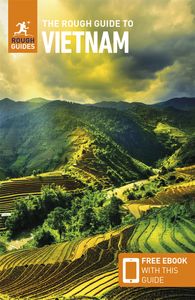The Crazy House
Gaudier than Gaudí, the Crazy House is easily combined with a visit to Bao Dai’s Summer Palace. Shaped to resemble the knotted trunks of huge trees, it’s a place that visitors – not to mention the citizens of Da Lat – either love or hate. While most merely pop by for a visit, this place also functions as a guesthouse; day-visitors are still welcome to look around any unoccupied rooms, most of which have entertaining Alice in Wonderland-style interiors with mirrors and mushrooms in abundance. A selection of photographs on the walls inside the entrance provides clues as to how such a bizarre construction got planning permission – its owner, Hang Nga, is the daughter of former president Truong Chinh, and was therefore above the usual planning constraints.
Bao Dai’s Summer Palace
Also known as Dinh III, the erstwhile summer palace of Emperor Bao Dai is a suitably splendid place to visit. Built between 1933 and 1938, it provided Bao Dai with a bolthole between elephant-hunting sessions. The building is palatial, though not in a traditional style – Art Deco would be a better description. Etched with stark white grouting, its mustard-coloured bulk is set amid rose and pine gardens. Nautical portholes punched into its walls give it the distinct look of a ship’s bridge, as does the mast-like pole sprouting from its roof. The place has all the usual attractions – pony rides and the chance to dress up in costumes – and the exit forces you to pass through a gauntlet of souvenir stalls.
Activities in and around Da Lat
There is some spectacular scenery in the vicinity of Da Lat, which lends itself to challenging treks, bike rides and other adventure activities.
Bike riding
There are a number of excellent day- and half-day bike routes around Da Lat. Many head north to Lat Village or south into the countryside, but it’s also possible to organize trips to further-flung locations such as Buon Ma Thuot, Nha Trang or even Hoi An.
Canyoning
There’s a beautiful canyon fifteen minutes from Da Lat by car, though the adventurous climbing course requires ropes and a bit of bravery. Groovy Gecko run full-day ones to the Dasara Falls, whose four cascades range in height from 8–65m.
Golf
The eighteen-hole Da Lat Palace course just north of the lake boasts inspiring views from some tees.
Hiking
Most local tour operators will be able to organize guided hikes, with everything from half-day to week-long walks and treks. Again, Lat Village and the surrounding area is a popular destination, though the operators here will be able to take you into more far-flung territory.
Tennis
Both the Dalat Palace and Dalat Du Parc have tennis courts, available to guests for free and non-guests for a small fee.
Whitewater rafting
The operators here run rafting and kayaking trips on routes including rapids of class 2, 3 and 4.
Tour Operators
A number of local tour operators can help to organize most of the activities here. Hotel pick-up usually comes as part of the package.
Best places to stay in Da Lat
Enduringly popular with both Western and domestic tourists, Da Lat has a wide range of places to stay, from cheap, windowless rooms to luxury, international-standard hotels. However, if your visit coincides with a public holiday, especially Tet, be warned that prices increase by up to fifty percent, and you’ll need either to arrive early or book ahead. The densest concentration of budget hotels lies on Phan Dinh Phung; ask for a room at the back, as the main road can be noisy. Several upmarket hotels operate downtown, but there are many more out in the open spaces south and west of the city centre. Check that prices include hot water – a luxury in much of southern Vietnam, but a necessity in Da Lat. Air-conditioning is neither necessary nor usually provided.





















